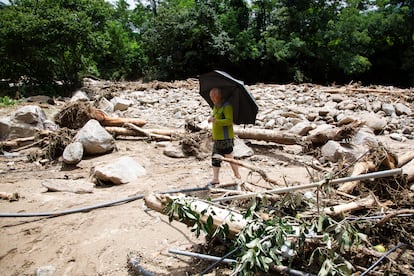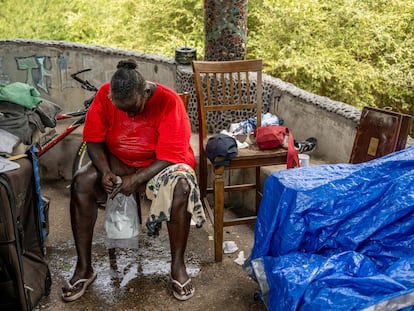South Korea’s death toll from destructive rainstorm grows to 40 as workers search for survivors
At least 34 people are injured and more than 10,000 people have had to evacuate from their homes since July 9, when heavy rain started pounding the country

Heavy downpours lashed South Korea for a ninth day on Monday as rescue workers struggled to search for survivors in landslides, buckled homes and swamped vehicles in the most destructive storm to hit the country this year.
At least 40 people have died, 34 others are injured and more than 10,000 people have had to evacuate from their homes since July 9, when heavy rain started pounding the country. The severest damage has been concentrated in South Korea’s central and southern regions.
In the central city of Cheongju, hundreds of rescue workers, including divers, searched for survivors in a muddy tunnel where about 15 vehicles, including a bus, were trapped in a flash flood that may have filled up the passageway within minutes Saturday evening.
The government has deployed nearly 900 rescue workers to the tunnel, who have so far pulled up 13 bodies and rescued nine people who were treated for injuries. It wasn’t immediately clear how many people were in the submerged cars.
As of Monday afternoon, rescuers had pumped out most of the water from the tunnel and were searching the site on foot, a day after they used rubber boats to move and transport bodies on stretchers.
Hundreds of emergency workers, soldiers and police were also looking for any survivors in the southeastern town of Yecheon, where at least nine people were dead, and eight others listed as missing after landslides destroyed homes and buckled roads, the county office said.
Photos from the scene showed fire and police officers using search dogs while wading through knee-high mud and debris from destroyed homes.
Nearly 200 homes and around 150 roads were damaged or destroyed across the country, while 28,607 people were without electricity over the past several days, the Ministry of the Interior and Safety said in a report.
Severe weather was also affecting many other places around the world. In the United States, an already saturated Northeast began drying out Monday after a second round of heavy rain in a week, including a flash flood in Pennsylvania that claimed at least five lives over the weekend.
Schools and the stock market were closed in Hong Kong on Monday as Typhoon Talim sideswiped the city and headed toward the Chinese mainland and the island province of Hainan.
This year has seen record-breaking stretches of high heat across large parts of China, South Korea and Japan. China’s National Meteorological Administration reported that temperatures in the oasis city of Turpan in the northwestern Xinjiang region hit a record 52.2 Celsius (125.9 Fahrenheit) on Sunday.
Italian health officials intensified heat warnings as southern Europe began a brutally hot week on Monday, with temperatures expected to top 40 C — or 104 F — on a continent already overburdened by tourists. The third heatwave in a month was expected to affect much of the Mediterranean and last until Wednesday.
In South Korea, the Korea Meteorological Administration maintained heavy rain warnings across large swaths of the country. Torrential rains were dumping up to 3 centimeters (1.2 inches) per hour in some southern areas. The office said the central and southern regions could still get as much as 20 centimeters (7.9 inches) of additional rain through Tuesday.
Returning from a trip to Europe and Ukraine, South Korean President Yoon Suk Yeol held an emergency government meeting. He called for officials to designate the areas hit hardest as special disaster zones to help funnel more financial and logistical assistance into relief efforts.
Yoon later visited Yecheon where he was briefed on the search and rescue efforts.
Sign up for our weekly newsletter to get more English-language news coverage from EL PAÍS USA Edition
Tu suscripción se está usando en otro dispositivo
¿Quieres añadir otro usuario a tu suscripción?
Si continúas leyendo en este dispositivo, no se podrá leer en el otro.
FlechaTu suscripción se está usando en otro dispositivo y solo puedes acceder a EL PAÍS desde un dispositivo a la vez.
Si quieres compartir tu cuenta, cambia tu suscripción a la modalidad Premium, así podrás añadir otro usuario. Cada uno accederá con su propia cuenta de email, lo que os permitirá personalizar vuestra experiencia en EL PAÍS.
¿Tienes una suscripción de empresa? Accede aquí para contratar más cuentas.
En el caso de no saber quién está usando tu cuenta, te recomendamos cambiar tu contraseña aquí.
Si decides continuar compartiendo tu cuenta, este mensaje se mostrará en tu dispositivo y en el de la otra persona que está usando tu cuenta de forma indefinida, afectando a tu experiencia de lectura. Puedes consultar aquí los términos y condiciones de la suscripción digital.
More information
Archived In
Últimas noticias
What is known about the Interoceanic Train derailment in Oaxaca
Trump turns a Minnesota fraud allegation into ammunition for his MAGA army against Democrats
The year Trump created 1.6 million undocumented immigrants
Russia threatens to break off negotiations after accusing Ukraine of attacking one of Putin’s residences
Most viewed
- Reinhard Genzel, Nobel laureate in physics: ‘One-minute videos will never give you the truth’
- Oona Chaplin: ‘I told James Cameron that I was living in a treehouse and starting a permaculture project with a friend’
- Pablo Escobar’s hippos: A serious environmental problem, 40 years on
- Chevy Chase, the beloved comedian who was a monster off camera: ‘Not everyone hated him, just the people who’ve worked with him’
- Why we lost the habit of sleeping in two segments and how that changed our sense of time










































